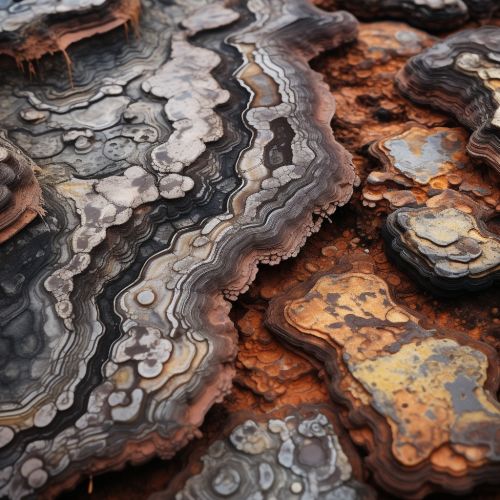Silicification
Introduction
Silicification is a diagenetic process that involves the replacement of original minerals, typically carbonates, with silica. This process is significant in the field of geology, as it aids in the preservation of fossils and the formation of various rock types. Silicification can occur in various environments, including marine, lacustrine, and terrestrial settings, and is influenced by a range of factors such as temperature, pressure, and the availability of silica.
Process of Silicification
The process of silicification involves the dissolution of original minerals and the precipitation of silica in their place. This process typically occurs in the presence of silica-rich fluids, which can be derived from the weathering of silicate rocks or the dissolution of biogenic silica. The silica is transported in solution as silicic acid, which can precipitate as silica when conditions are favorable. The precipitation of silica can occur through various mechanisms, including the evaporation of water, the cooling of the solution, or changes in pH or ionic strength.


Factors Influencing Silicification
Various factors can influence the process of silicification, including the temperature and pressure of the environment, the availability of silica, and the nature of the original minerals. High temperatures and pressures can increase the solubility of silica and promote its transport in solution, while the presence of certain ions, such as magnesium and calcium, can inhibit the precipitation of silica. The nature of the original minerals can also influence the process of silicification, as some minerals are more susceptible to replacement by silica than others.
Types of Silicification
There are several types of silicification, including permineralization, petrifaction, and replacement. Permineralization involves the precipitation of silica within the pores and cavities of the original material, while petrifaction involves the complete replacement of the original material with silica. Replacement silicification can occur at the microscopic scale, where individual crystals are replaced by silica, or at the macroscopic scale, where large structures or even entire organisms are replaced.
Role in Fossil Preservation
Silicification plays a crucial role in the preservation of fossils, as it can preserve the fine details of the original material. This process can occur in various environments and can preserve a wide range of organisms, from microscopic algae to large trees. The resulting silicified fossils provide valuable information about the morphology and ecology of ancient organisms, and can help to reconstruct past environments and climates.
Silicified Rocks
Silicification can result in the formation of various rock types, including chert, flint, jasper, and opal. Chert and flint are composed of microcrystalline or cryptocrystalline silica, and are often found in limestone or chalk. Jasper is a variety of chert that is red, yellow, or brown, due to the presence of iron oxides. Opal is composed of hydrated silica, and is often found in volcanic rocks or as a replacement of organic material.
